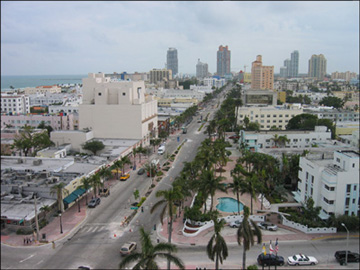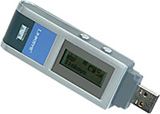Wi-Fi hotspots provide wireless Internet access within public areas. They enable people to keep up-to-date with their digital world in places such as cafés (as depicted in Figure 1-1), convention centers, libraries, and hotels. Users can connect to hotspots from mobile computers, such as laptops and Personal Digital Assistants (PDAs). Other media devices with Wi-Fi capability, such as the PlayStation Portable (PSP) or cellular phones, can also take advantage of hotspots. Wireless hotspots allow people to do such tasks as browse the Internet and send and receive e-mail. Wi-Fi hotspots are similar to wireless networks that are used in homes and businesses; however, they are not as secure, and they are intended for public use.
Hotspots provide broadband, or high-speed, Internet access. This type of connection is much faster than traditional Internet connections, such as dialup access using a telephone modem. However, the Internet speed that individual users experience while connected to a wireless network varies, depending on many factors, including the following:
The size and configuration of the hotspot
The number of concurrent users
What the users are doing on the network
For example, the Internet speed for individual users on a hotspot might be faster if a few people are synchronizing e-mail, rather than a dozen users downloading large files or viewing streaming video on a website.
Note
A broadband Internet connection can support up to a 4500-kilobits per second (kbps) transfer rate. These Internet connections are much faster than what traditional 56-kbps telephone dialup modems provide. This speeds up web browsing and downloading for users.
Many types of hotspots exist throughout the world. Traditional hotspots provide coverage in and around a building or small group of buildings, such as restaurants, coffee shops, airports, and hotels. Access to hotspots can be free or fee-based. Even if Internet access on a hotspot is free, users might be required to register or view advertisements before accessing the Internet. Fee-based hotspots require users to register and purchase access time. These rates and times differ between each hotspot network. A typical hotspot network might have an access fee selection such as $6 for an hour of access, $10 for 24 hours, and $30 for unlimited access for a month. As discussed in the following case study, hotspots can be independent or part of a network or group.
E-mail and web browsing are available through most mobile phone service providers. However, these phones have limited keypads and displays. Devices such as the Blackberry offer quick and simple e-mail access and have had great success in the market. However, creating or viewing larger e-mail messages and viewing most websites are not practical. In addition, the data rates available through the cell systems are relatively slow. Therefore, people who have laptops and PDAs equipped with Wi-Fi connectivity can benefit much more by connecting to the Internet via a Wi-Fi hotspot, which offers a more effective user interface and much higher speed.
Most hotspots display a splash screen the first time a user connects and accesses the Internet with a web browser. With free hotspots, this splash screen might require the user just to accept terms and conditions (the “fine print”) or view advertisements before accessing the Internet connection. If the hotspot is fee-based, a user would enter his logon information or sign up and set up payments if he has not used that hotspot network before. In most cases, the fee-based hotspots accept payments by having the user securely enter credit card information.
Wi-Fi hotspots bridge the Wi-Fi connectivity gap between wireless networks in homes and businesses. People can access e-mail and other online services between home and work or while traveling. This allows them to keep up with customers, associates, and family members.
Wi-Fi hotspots are found in many public places where people might want to pop open their laptop and browse the Internet. Following are some typical places where you might find a Wi-Fi hotspot:
Cafés, restaurants, and bars
Hotels, motels, and bed-and-breakfast inns
Bookstores and libraries
Office building reception areas
Airports
Airplanes
Clubs and organizations
As discussed in the preceeding case study, cafés and restaurants provide wireless Internet access for customers while they are enjoying their food and beverages. Along with other businesses and organizations, cafés and restaurants will likely benefit with more foot traffic to their location when they provide this convenient Internet service to customers and visitors.
A majority of travelers these days choose only hotels that provide broadband Internet access within the rooms. This lets people keep in touch with their online world while they are out of town. Some hotels provide a wired Internet connection—usually an Ethernet or data port. Ethernet provides broadband Internet access similar to Wi-Fi, but Ethernet requires a cable to connect the user laptop to the network. This restricts the user to a single location in the room—usually a desk. In addition, most hotels provide a data port on the telephone for dialup modem users to plug into. This also requires a restrictive cable connection, and the performance is slow and unusable for some websites and e-mail attachment downloads.
Even though wired Internet connections are widely available, most people prefer Wi-Fi Internet access. This enables guests to move about the hotel and still be connected to the Internet. For example, a business traveler can use the Internet from anywhere within the room, such as from the desk, as shown in Figure 1-2, or while relaxing on the bed. In addition, this person can go down to the bar or lobby and still have Internet access. A Wi-Fi network in a hotel also becomes useful when one or more people with laptops are staying in the same room, because wired connections allow only one person at a time to use the Internet.
Students, businesspeople, and others typically use Wi-Fi hotspots at local bookstores and libraries while working on homework or work-related tasks. Bookstores typically did not have Internet access before they began offering Wi-Fi access. For years, libraries have had computer workstations connected to the Internet for public use.
Yet offering Wi-Fi Internet access helps eliminate some costs, enables more people to use the Internet at once, and lets users move about the building while using Internet applications.
Corporations in the past did not have Internet access available for visitors throughout their office buildings because of the difficulties in allocating a wired connection. In most cases, an unused wired Ethernet port is not available or is in a physical location where it is not practical for the visitor to access it. An open port, for example, could be located on the wall within the conference room. Regularly scheduled meetings in the conference room would likely get in the way of the visitor using the room to use the network connection. Visitors such as salespeople, customers, and consultants, though, can definitely benefit from Wi-Fi Internet access while inside the facility, even if the wireless network is made available only from specific places, such as the company lobby, and kept separate from the corporate network.
Wi-Fi Internet access within airports enables travelers, such as shown in Figure 1-3, to send and receive e-mail and conduct other necessary tasks while traveling. This is useful during long layovers between flights and unscheduled delays or cancellations. Many airports today still have not installed wireless hotspots. Given that airports can be extremely large, this could be an expensive task for the airport authorities. However, even installing a small hotspot within specific restaurants, airline clubs, or concourses of the airport would be useful to travelers.
Wi-Fi access is also available while onboard aircraft during some international airline flights. The Federal Aviation Administration (FAA) at the time of this writing prevents airlines that are flying domestically in the United States from offering Wi-Fi on airplanes, however. When Internet access on airplanes becomes widely accepted, many people will benefit, especially during longer flights. Business travelers will certainly be more productive if they can correspond via e-mail and use Internet-based applications while they are restricted to an airplane seat.
Many businesses today, such as those discussed in the preceding paragraphs, are setting up hotspots throughout all their locations, or franchisees. Table 1-1 lists a few examples.
Wi-Fi hot zones, also known as Wi-Fi clouds, provide public Internet access, just like hotspots, but they cover a larger area, such as that shown in Figure 1-4, and they are typically for use outdoors. These hot zones might cover anywhere from a city block to an entire city, commonly referred to as a muni or municipal network, or even a whole county.
Even though end users in these hot zones connect using Wi-Fi, these systems typically use a different design approach, called mesh networking, instead of the traditional wireless LAN infrastructure, such as in Wi-Fi hotspots.
Along with giving citizens and visitors convenient Internet access, these wireless networks might provide a concurrent private network and Internet connections over the same system. Companies might be able to purchase a secure Internet connection for their business, and city departments could support communication services such as parking and utility meters and city cameras.
Note
Larger wireless networks such as city-wide or corporate networks provide private and public access simultaneously by using VLANs. VLANs provide secure and logical separation for both the private and public network users while requiring only one physical network infrastructure.
Following is a short list of the cities that are filling the streets with Wi-Fi signals:
Tulsa, Oklahoma
Cape Cod, Massachusetts
Sunnyvale, California
Daytona Beach and Panama City, Florida
More and more cities are hopping on the muni Wi-Fi bandwagon, trying to keep up with the digital world and wanting to attract people and businesses to their area.
These hot zones are convenient, allowing people to check their e-mail and browse the Internet pretty much anywhere outdoors within the coverage area. In some cases, users can even access the Internet in moving vehicles, where traditional hotspots do not cover.
Note
Even though metropolitan Wi-Fi networks are getting popular, traditional small hotspots will always be important, especially in towns where muni access is not available. Even in cities that have municipal Wi-Fi networks, the lack of coverage within buildings and the inability to provide perfect connections to users from every nook and cranny ensures that certain people will need and use traditional small hotspots.
People find hotspots in many different ways:
Online directories
Software directories
Display signs
Wi-Fi finders
Laptops/PDAs
People who want Internet access while traveling can find hotspots in particular areas by searching online directories. They can view pertinent details of the hotspots, such as the service set identifier (SSID), also referred to as the hotspot’s network name, and whether the network is free or fee-based. The following are a few websites offering online directories that people can use to find hotspots:
Many of the major hotspot networks and online directories also offer a free software program that people can download and install on their computers. This allows travelers who are on the go—even in the car or airport—to quickly find hotspots without an Internet connection. Following are a few websites that offer offline or downloadable software directories:
Many businesses and organizations display signs throughout their facility indicating that they host a public hotspot. The display of door, counter, and street signs helps notify people passing by or through the location of the Wi-Fi hotspot.
Figure 1-5 shows a typical device called a Wi-Fi finder, which provides a way for gadget lovers to find hotspots. This immediately lets someone know if a wireless network is nearby, without the hassle of the user taking out and booting up his laptop. The features and functionality of these devices differ greatly, depending on the manufacturer. Some finders notify the user of Wi-Fi networks just by illuminating a certain light. More advanced finders might have a small screen that displays important information about the detected network, such as the SSID, security level, and signal strength.
Wi-Fi finders are convenient; however, they might notify you of every wireless network nearby, not just the public hotspots. Wireless networks that are intended for private use can be secured so that the public cannot connect. Nevertheless, a good percentage of businesses and consumers do not fully understand the security risks and do not properly secure their network. If a private wireless network is not properly secured, anybody can potentially connect and access the Internet and files on the network. Thus, some people think that just because they can connect to a network, it is a hotspot and it is open to the public. Instead, some of these Wi-Fi networks belong to private citizens and businesses. They might not be intended for public use and might even be unlawful to use.
Note
If you are unsure whether a certain wireless network is a public hotspot, you should find the network’s owner and ask, because that is the only way to be certain.
Many people find Wi-Fi hotspots simply by booting up their laptop or PDA and viewing the available wireless networks in the area. This also brings up the issue that some networks might not be intended for public use. Users should look for networks that are clearly identified for public use.
Wireless networks use a technology that is specified within a standard called 802.11. The standard is basically written documents formed by members of the IEEE. These documents help manufacturers develop wireless products so that they will work together with wireless products from every vendor that follows the standard.
The 802.11 standard has a few versions:
802.11a
802.11b
802.11g
These versions of 802.11 have different characteristics, such as data rate, frequency, and transmit power limits. The most widely used standard today is 802.11g, which is similar to 802.11b. However, it can handle a much greater data rate, up to 54 Mbps. The details of these standards are discussed in Appendix A, “Understanding Wi-Fi Signals.”
The word “Wi-Fi” that is used throughout the market was created by the Wi-Fi Alliance, a nonprofit industry trade association devoted to promoting the growth of wireless local-area networks (WLAN). The Wi-Fi Alliance certifies products to ensure the interoperability of WLAN products from different manufacturers and try to promote the use of these devices. The Alliance defines the word “Wi-Fi” as follows:
A term developed by the Wi-Fi Alliance to describe wireless local-area network (WLAN) products that are based on the IEEE 802.11 standards.
Other people describe the term “Wi-Fi” as wireless fidelity, or freedom from wires.
Most wireless networks operate in a similar way, regardless of whether it is a private or public network. Cities, however, typically use mesh networking technology to help simplify the installation and operation of such a large network. Smaller hotspots use an infrastructure that is similar to wireless networks in homes and businesses.
The three main components of infrastructure wireless networks are as follows:
Internet service
Internet modem
Wireless router
Figure 1-6 shows a simple layout of a Wi-Fi network. This is not necessarily how a hotspot or any specific network is set up. It merely shows a basic configuration of a wireless network.
Of course, to provide wireless Internet to users, you must have some type of Internet service connected to the network. Most Internet service providers (ISPs) supply a modem and usually hook it up for you. The Internet modem physically connects to the Internet line (as shown in Figure 1-6), such as a DSL or TV cable jack.
The wireless router (as shown in Figure 1-6) takes a single Internet connection and distributes usage among wired and wireless users on the network. All wireless devices on the network communicate through the wireless router. It is the controller and coordinator for all the wireless traffic.
Note
Wireless networks that need to cover an area beyond that of a single wireless router use multiple access points instead of wireless routers. Only one device on the network needs the ability to route and regulate traffic on the network. Therefore, larger networks have many access points that do not have routing features, connected to a separate piece of hardware that does the routing.
This chapter discussed that the intention of Wi-Fi hotspots and hot zones is to give the public high-speed wireless Internet access. In addition, keep in mind the main points covered in this chapter:
Hotspots are typically located indoors and provide a relatively small coverage area, whereas hot zones provide access outside over a much larger area.
Wi-Fi hotspots allow people to check e-mail, surf the web, and perform other online tasks while they are away from home or work.
A few types of hotspots exist:
Free or fee-based
Hotspot network or independent
The most widely used standard for Wi-Fi hotspots today is 802.11g.






